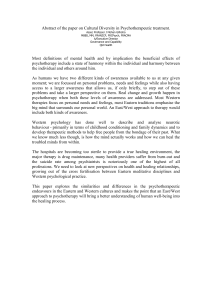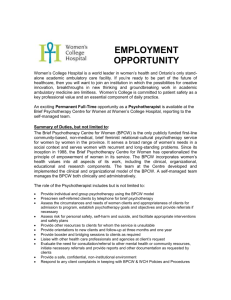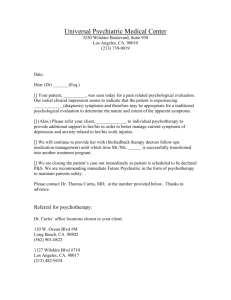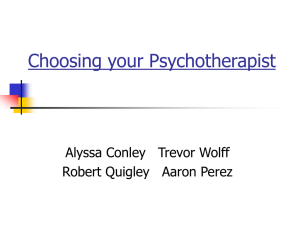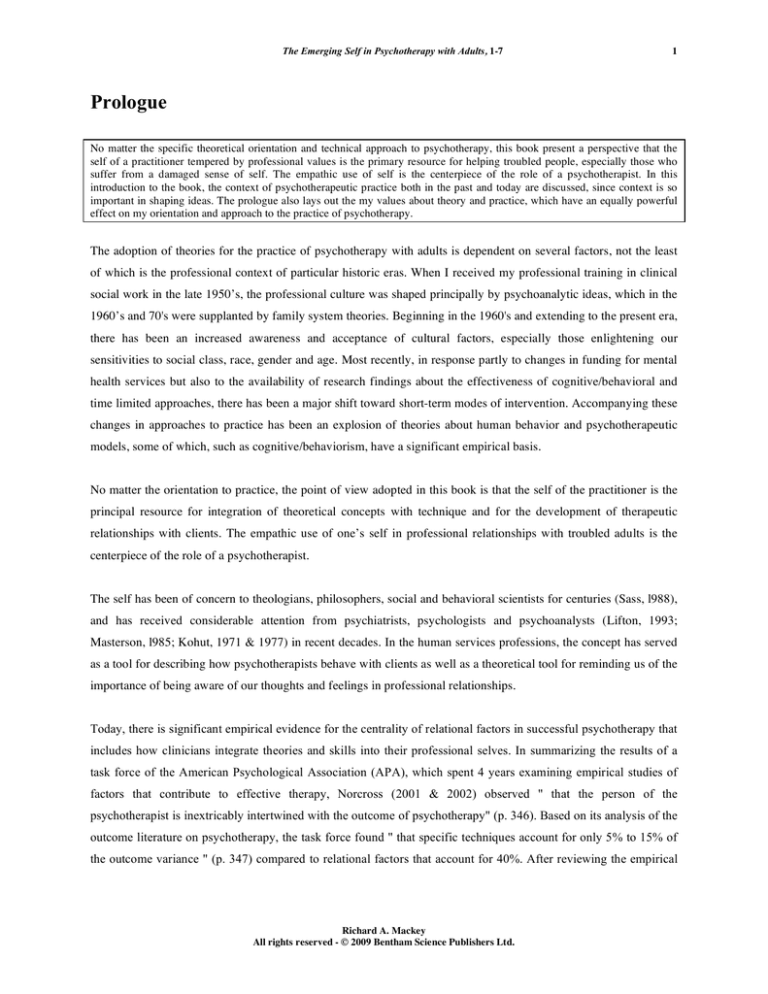
The Emerging Self in Psychotherapy with Adults, 1-7
1
Prologue
No matter the specific theoretical orientation and technical approach to psychotherapy, this book present a perspective that the
self of a practitioner tempered by professional values is the primary resource for helping troubled people, especially those who
suffer from a damaged sense of self. The empathic use of self is the centerpiece of the role of a psychotherapist. In this
introduction to the book, the context of psychotherapeutic practice both in the past and today are discussed, since context is so
important in shaping ideas. The prologue also lays out the my values about theory and practice, which have an equally powerful
effect on my orientation and approach to the practice of psychotherapy.
The adoption of theories for the practice of psychotherapy with adults is dependent on several factors, not the least
of which is the professional context of particular historic eras. When I received my professional training in clinical
social work in the late 1950’s, the professional culture was shaped principally by psychoanalytic ideas, which in the
1960’s and 70's were supplanted by family system theories. Beginning in the 1960's and extending to the present era,
there has been an increased awareness and acceptance of cultural factors, especially those enlightening our
sensitivities to social class, race, gender and age. Most recently, in response partly to changes in funding for mental
health services but also to the availability of research findings about the effectiveness of cognitive/behavioral and
time limited approaches, there has been a major shift toward short-term modes of intervention. Accompanying these
changes in approaches to practice has been an explosion of theories about human behavior and psychotherapeutic
models, some of which, such as cognitive/behaviorism, have a significant empirical basis.
No matter the orientation to practice, the point of view adopted in this book is that the self of the practitioner is the
principal resource for integration of theoretical concepts with technique and for the development of therapeutic
relationships with clients. The empathic use of one’s self in professional relationships with troubled adults is the
centerpiece of the role of a psychotherapist.
The self has been of concern to theologians, philosophers, social and behavioral scientists for centuries (Sass, l988),
and has received considerable attention from psychiatrists, psychologists and psychoanalysts (Lifton, 1993;
Masterson, l985; Kohut, 1971 & 1977) in recent decades. In the human services professions, the concept has served
as a tool for describing how psychotherapists behave with clients as well as a theoretical tool for reminding us of the
importance of being aware of our thoughts and feelings in professional relationships.
Today, there is significant empirical evidence for the centrality of relational factors in successful psychotherapy that
includes how clinicians integrate theories and skills into their professional selves. In summarizing the results of a
task force of the American Psychological Association (APA), which spent 4 years examining empirical studies of
factors that contribute to effective therapy, Norcross (2001 & 2002) observed " that the person of the
psychotherapist is inextricably intertwined with the outcome of psychotherapy" (p. 346). Based on its analysis of the
outcome literature on psychotherapy, the task force found " that specific techniques account for only 5% to 15% of
the outcome variance " (p. 347) compared to relational factors that account for 40%. After reviewing the empirical
Richard A. Mackey
All rights reserved - © 2009 Bentham Science Publishers Ltd.
2
The Emerging Self in Psychotherapy with Adults
Richard A. Mackey
evidence from more than 100 studies, Lambert and Barley (2001) concluded "that relationship factors correlate more
highly with client outcome than do specialized treatment techniques” (p. 359).
The work of the APA task force underscores the importance of factors within psychotherapeutic relationships to
treatment effectiveness. That research does not dismiss the importance of other factors, which include client
expectations, technique and circumstances extraneous to therapy itself, but does suggest that factors in professional
relationships common to a wide range of therapies occupy a central role in working with troubled human beings.
In addition, there is now a suggestion, based on early empirical evidence, of an important link between the quality of
empathically informed therapeutic relationships and modifications in the underlying neural structures of clients who
suffer from damaged selves. This research suggests that a new and potentially healing attachment between a client
and a therapist is the vehicle for facilitating amelioration of damage from previous relationships (Attachment and
related disorders, 2005). These data may extend the empirical evidence of a link between loving attachment
relationships and the development of neurological structures in infants (Schore, 1994), despite the obvious
differences in maturational levels of adults and children.
Because the relationship is always the medium for delivery of services, it is important, indeed critical, for students
and practitioners to have a firm grounding in a concept of the self that encompasses bio-neurological, psychological
and socio-cultural factors. While we focus on and deal primarily with psychosocial factors in psychotherapy, it is of
critical importance to incorporate an understanding of biological factors in our work with clients. Not only may this
grounding facilitate an empathic understanding of the people we serve, but may also become a resource for
deepening and broadening awareness of ourselves in professional relationships.
This book is intended to complement existing theories by offering psychotherapists and students, who are preparing
for careers in the human services, a perspective on the dynamic inner life of human beings as they live out their lives
in the context of human relationships. Regardless of one’s theoretical orientation and the professional suit one
chooses to wear in practice, an understanding of the structure and development of the self are important elements in
professional education and in successful therapy with clients.
In more than 40 years of practice as a clinical social worker, I have rarely known adult clients who did not suffer
from significant damage to their selves as a result of abusive, neglectful, indifferent and oppressive relational
experiences. These survivors, many of whom are some of the most vulnerable members of society, are increasingly
the primary clients of social work and the other human service professions. They deserve practitioners who bring to
therapeutic relationships an understanding of how the self emerges over the life span within the contexts of human
relationships. There is no more effective route to such an understanding than theory based on relevant research
complemented by an examination of one’s own developmental and professional experiences.
Prologue
The Emerging Self in Psychotherapy with Adults
3
I have listened to graduate students and experienced practitioners who have been open to exploring their
professional development toward the goal of defining their sense of a professional self. They have been exceedingly
generous in sharing what it has meant to them to become a competent psychotherapist (Mackey, R. and Mackey, E.,
1994; Mackey, R. and Mackey, E., 1993 ; Mackey, R., Mackey, E. and O'Brien, B. (1993). At the heart of the
learning process has been a genuine desire and openness to integrate ideas about the self into their professional roles.
For the serious learner, that process involves a personal commitment to understanding how one’s background, that
has become part of the adult self, shapes professional roles and behaviors. The professional self builds upon the
sense of self that has become a part of us from birth.
In my 1985 book, Ego psychology and clinical practice, a framework for practice was presented based on the
structure and functions of the ego. The concept of self is more encompassing than that of ego, yet has continuity
with the rich tradition of understanding human development from that perspective. While ego is defined by its
psychological functions, a sense of self involves how one experiences - behaviorally, cognitively and emotionally body and mind within the context of social roles and relationships, including professional ones. From birth, there is a
quest for an integrated sense of self - biologically, psychologically and socially - that is only possible through
involvement in meaningful relationships. Contemporary research points to the quality of child care, parental
attunement to the needs of children, a positive emotional environment in the home and stimulation for cognitive
development as the basis for that quest (Lewin, 2002).
What we are and who we become are shaped within relationships with others whose presence in our lives has
significance for our well being. These experiences begin with primary figures in our families without whom we
cannot survive and only with whom does a sense of self begin to emerge (Stern, 1985). That core of the self, shaped
by interpersonal experiences with primary figures, serves as a resource for intellectual and emotional learning across
the life span. That inner sense of who we are serves as a template, a "working model," for subsequent development
(Bowlby, 1969, 1973 & 1980). Longitudinal studies (Karr-Morse & Wiley, 1997) suggest a connection between the
quality of early attachments and subsequent behaviors, although the nature of that link is not well understood
(Basham and Miehls, 2004).
As development unfolds, relationships with other human beings, who are experienced in the neonatal period as
extensions of our rudimentary sense of self, change both in terms of quality and quantity. The enmeshed nature of
these earliest attachments takes on a separate quality, both with original figures and with subsequent ones. If
developmental experiences are optimal or "good enough" (Greenberg & Mitchell, 1983), we ingest psychologically
the empathic gifts of those who love us. As this process of internalization unfolds, we emerge from earliest
relationships with a sense of a consolidated self characterized by confidence, curiosity and initiative. After
childhood and adolescence, the quest toward integration is facilitated through psychologically intimate adult
relationships (Mackey, Diemer, and O'Brien, 2000).
4
The Emerging Self in Psychotherapy with Adults
Richard A. Mackey
So many of the adult clients whom we serve today have not had the kind of early experiences with primary figures
to which all children are entitled. They may be the casualties of empathetically impoverished families, indifferent
communities and societal hostility to their existence. As a consequence, so much of development for these human
beings may be a series of noxious experiences: instead of joy there is persistent sadness, instead of optimism there is
nagging despair and instead of wholeness there is disjointed fragmentation.
In spite of differences in the clothing that we put on in our professional roles, we are similar to the people whom we
serve in real yet invisible ways. Historically, several writers who have a humanistic orientation to understanding the
self and relationships have recognized this: Towle (1955) referred to this connection in the concept of "common
human needs," Berl (1988) in the idea of "human unity," and Buber in the "I-Thou" relationship (Smith, 1975).
Constitutional factors, developmental experiences and contextual realities may differ but the emotional
consequences of those experiences deep within ourselves may have a semblance to and may resonate with the inner
world of others, especially those whom we call clients. That is, no matter how good the experiences with primary
figures, they will never be "good enough" not to leave us with some residues of shame, guilt and doubt about
ourselves. We all thirst for meaningful relationships throughout life with those who know and love us, who confirm
our worth, who recognize our individuality and who respect us for what we are rather than what they and others may
ask us to be. These meaningful connections with others are the basis for "human unity" and the "I thou relationship."
The human capacity to attune to another individual while respecting that person’s separateness from us is the
essence of empathy, which, I believe, is central to understanding relational factors identified in the APA study
(Norcross 2001).
How we think and feel about our bodies, our minds and our relationships is what shapes and gives substance to the
sense of self. Themes of an emotional and cognitive nature that have become a part of us through processes of
learning are significant components of the self. I have given much thought to the continuity of biological growth and
psychosocial development and wonder about the connections between the self that emerges within the context of
family, community and culture and the self which one begins to adopt during professional education and throughout
one’s career. My thoughts centered on the nature and importance of the continuity between the personal level of self
and the professional level manifested in professional roles and relationships, the vehicles through which help is
offered to another human being. There is a paradox between these levels. The use of ourselves in professional roles
and relationships is an inherent part of our sense of self. Yet, there is a difference between the personal and
professional just as there may be differences in the various roles that are adopted in life, including those of
psychotherapist. To accept the similarities while respecting the differences is one of the most challenging tasks in
developing a genuine professional self.
As empathic relationships are central to healthy development so too are empathic relationships central in the process
of helping another human being, not a new idea but one that may be secondary to technique in some models of
practice. Constraints imposed by time and the pressure to produce results that are measurable empirically may also
Prologue
The Emerging Self in Psychotherapy with Adults
5
obscure the instrumental role that empathy and the therapeutic relationship play in the helping process. I believe that
psychoeducational interventions based on cognitive/behavioral ideas need to be grounded in empathic relationships
informed by respect, acceptance and understanding of clients. While technical skills change as a result of new
knowledge based on sound research, relational skills informed by empathic understanding remain relatively constant
over time. The empathic function within the professional self is the means for helping clients to integrate new
learning about their selves and to modify undesirable behaviors. I have always believed that the process of
integration is most effective when a client experiences a therapist as competent but also as empathic. That is the
psychotherapeutic road for enabling a new sense of self to emerge. To that end, the book is organized as follows:
Chapter one presents a theoretical model for understanding the self as the sense of one’s biological, psychological
and social being in the context of time and space. Three theories that appear to be most germane to understanding
how a sense of self develops, notably during childhood, are discussed in the second chapter. They are: attachment,
self psychology and object relations theories. An essential aspect of understanding the self throughout life is
meaningful relationships. One's sense of self is embedded in such relationships beginning with the nurturing parental
relationship and extending into adult loving partnerships. Based on our research into understanding relationships,
chapter three focuses on how meaningful adult relationships, characterized by psychological intimacy, are
instrumental to the emerging self during adulthood (Mackey, Diemer & O'Brien, 2000).
The foci of subsequent chapters reflect the roles that I have played in my professional career: psychotherapist,
teacher and researcher. In the fourth chapter, there is a discussion of the damaged self within adult clients who may
confront us with considerable challenges in psychotherapeutic relationships. More often than not, these clients have
been the focus of my practice. I have learned a lot from them, which is illustrated through a case study of one client.
Chapter five focuses on the role of a therapist and on exploratory, supportive, confrontive, and educative skills that
define the professional self. Again, psychotherapy with one of my former clients is used. Tape recordings from two
sessions, one in the middle of therapy and the other a year later, are used to illustrate those psychotherapeutic skills
as well as to show how the client viewed the helpfulness to non-helpfulness of our work. In chapter six, a model of
therapy with couples based on our lasting relationships research is presented (Mackey, Diemer & O'Brien, 2000).
This model of couples therapy is very timely in view of the confluence of recent studies that suggest the importance
of working with the natural ways of how couples manage conflict rather than imposing a model of therapy on them
(Jacobson et. al., 2000; Gottman, Coan, Carrere and Swanson, 1998). The final chapter focuses on the meaning of
personal psychotherapy to the role of a psychotherapist, which is based on a study of graduate students and
experienced practitioners in clinical social work (Mackey & Mackey, 1993). Although surveys indicate that most
practitioners in the human services will be involved in personal therapy at some point in their careers (Norcross, J.,
et al, 1988), there is relatively little research on the topic. For many practitioners, regardless of their disciplines,
personal therapy may be a valuable resource in the development of their professional selves.
6
The Emerging Self in Psychotherapy with Adults
Richard A. Mackey
References
Attachment and related disorders (2005). Conference: Harvard Medical School, Department of Continuing Education, May 6-7
Boston, MA.
Basham, K. and Miehls, D. (2004). Transforming the legacy: Couple therapy with the survivors of childhood. NY: Columbia
University Press.
Berl, F. (1988). Social change and social work practice: Writings of Fred Berl. Hagerstown, MD.: Hagerstown Bookbinding and
Printing Company.
Bowlby, J. (1980). Attachment and loss (Vol.3). NY: Basic Books.
Bowbly, J. (1973). Seperation: Anxiety and anger (vol.2). NY: Basic Books.
Bowbly, J. (1969). Attachment (vol.1). NY: Basic Books.
Erikson, E. (1950). Childhood and society. NY: W. W. Norton and Co., Inc.
Gottman, J.M., Coan, J., Carrere, S. and Swanson, C. (1998). Predicting marital happiness and stability from newlywed
interactions. Journal of Marriage and the Family, 60, 5-22.
Greenberg, J. and Mitchell, S. (1983). Object relations in psychoanalytic theory. Cambridge, MA: Harvard University Press.
Hoffman, M. (1977). “Empathy, its development and prosocial Implications” In C.B. Keasey (ed.), Nebraska Symposium on
Motivation,. University of Nebraska Press, 1977.
Joacobson, N. Christensen, A., Prince, S., Cordova, J. and Eldridge, K. (2000). Integrative behavioral couple therapy: An
acceptance-based, promising new treatment for couple discord. Journal of Consulting and Clinical Psychology, 68 (2),
351-355.
Karr-Morse, R. and Wiley, M. (1997). Ghosts from the nursery: Tracing the roots of violence. NY: The Atlantic Press.
Kohut, H. (1977). The restoration of self. NY: International Universities Press.
Kohut, H. (1971). The analysis of self. NY: International Universities Press.
Lambert, M. and Barley, D. (2001). Research summary on the therapeutic relationship and psychotherapy outcome.
Psychotherapy: Theory / Research / Practice / Teaching, 38 (4), 357-361.
Lewin, T. (2002). A child study is a peek, its not the whole picture. The New York Times, 07/21/2002.
Lifton, R.J. (1993). The protean self: Human resilience in an age of fragmentation. NY: Basic Books.
Mackey, R., Diemer, M. and O'Brien, B. (2000). Psychological intimacy in the lasting relationships of heterosexual and same sex
relationships. Sex Roles. 43(3/4), 2000, 201-227
Mackey, R., Diemer, M. and O'Brien, B. (2000). Conflict management styles of spouses in lasting relationships.
Psychotherapy:Theory/Research/Practice. 37(2) Summer, 134-148.
Mackey, R. and Mackey, E. (1994). Personal psychotherapy and the development of a professional self. Families in Society: The
Journal of Contemporary Human Services 75(8), 490-498.
Mackey, R. & Mackey, E. (1993). : The value of personal psychotherapy to clinical practice (1993) with E. Mackey. The Clinical
Social Work Journal. 21(1), 97-109.
Mackey, R., Mackey, E. and O'Brien, B. (1993). Personal psychotherapy and the social work student. Journal of Teaching in
Social Work. 7(2), 129-146.
Mackey, R. (1985). Ego psychology and clinical practice. NY: Gardner Press, Inc. also published by Boston College Press, 1992.
Prologue
The Emerging Self in Psychotherapy with Adults
7
Masterson, J. (l985). The real self: A developmental self and object relations approach. NY: Brunner/Mazel.
Norcross, J. (2001). Purposes and products of the task force on empirically supported therapy relationships. Psychotherapy:
Theory / Research / Practice / Teaching, 38 (4), 345-356.
Norcross, J. (2002). Psychotherapy relationships that work: Therapists contributions and responsiveness to patient needs. NY:
Oxford University Press.
Sass, L. (l988). The self and its vicissitudes: An archaeological study of the psychoanalytic avant-garde. Social Research, 55, 4
(Winter), 551-607.
Schore, A. (1994). Affect regulation and the origin of the self: The neurobiology of emotional development. Hillsdale, NJ:
Lawrence Erlbaum Associates.
Smith, R. (1975). Martin Buber. Atlanta, GA: John Knox Press.
Stern, D. (1985). The interpersonal world of the infant. NY: Basic Books.
Towle, C. (1955).Common human needs. NY: American Association of Social Workers.




